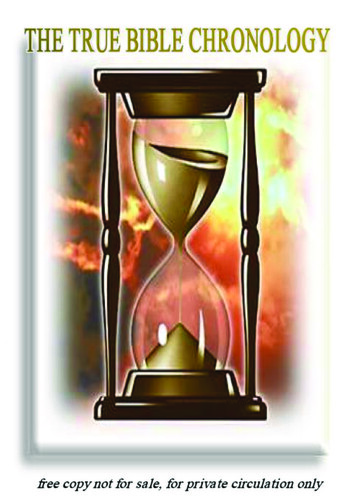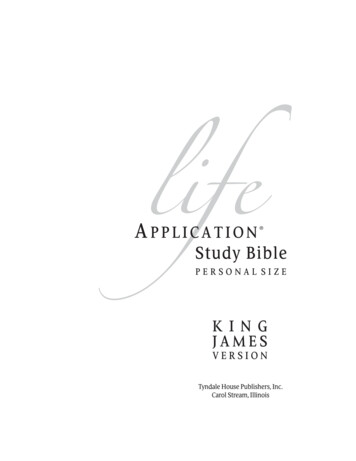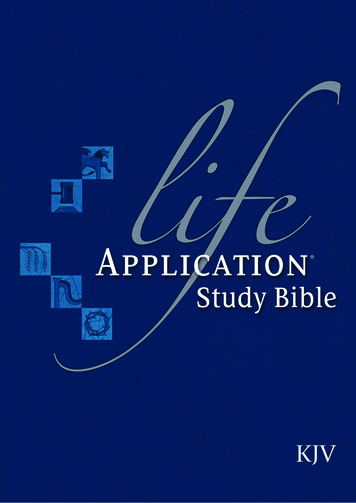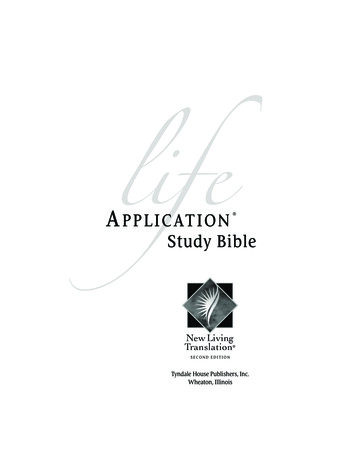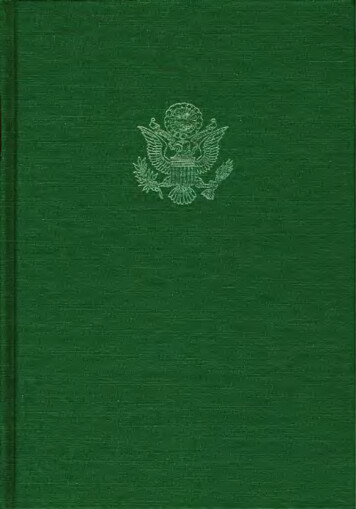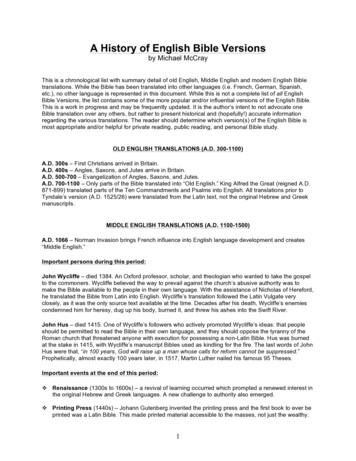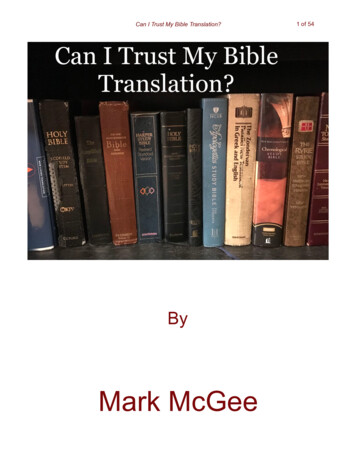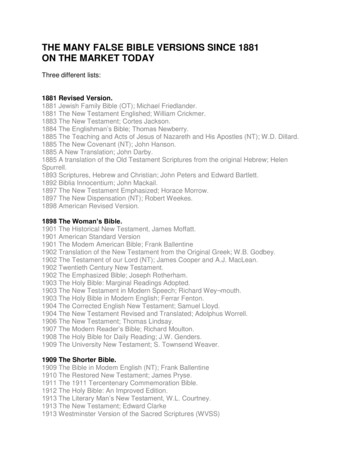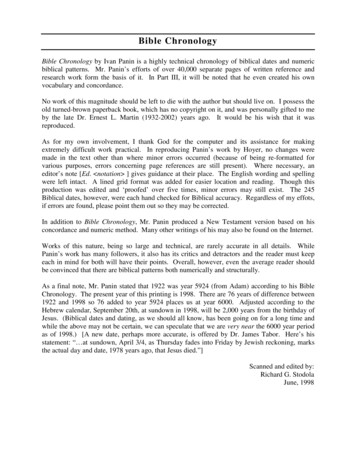
Transcription
Bible ChronologyBible Chronology by Ivan Panin is a highly technical chronology of biblical dates and numericbiblical patterns. Mr. Panin’s efforts of over 40,000 separate pages of written reference andresearch work form the basis of it. In Part III, it will be noted that he even created his ownvocabulary and concordance.No work of this magnitude should be left to die with the author but should live on. I possess theold turned-brown paperback book, which has no copyright on it, and was personally gifted to meby the late Dr. Ernest L. Martin (1932-2002) years ago. It would be his wish that it wasreproduced.As for my own involvement, I thank God for the computer and its assistance for makingextremely difficult work practical. In reproducing Panin’s work by Hoyer, no changes weremade in the text other than where minor errors occurred (because of being re-formatted forvarious purposes, errors concerning page references are still present). Where necessary, aneditor’s note [Ed. notation ] gives guidance at their place. The English wording and spellingwere left intact. A lined grid format was added for easier location and reading. Though thisproduction was edited and ‘proofed’ over five times, minor errors may still exist. The 245Biblical dates, however, were each hand checked for Biblical accuracy. Regardless of my effots,if errors are found, please point them out so they may be corrected.In addition to Bible Chronology, Mr. Panin produced a New Testament version based on hisconcordance and numeric method. Many other writings of his may also be found on the Internet.Works of this nature, being so large and technical, are rarely accurate in all details. WhilePanin’s work has many followers, it also has its critics and detractors and the reader must keepeach in mind for both will have their points. Overall, however, even the average reader shouldbe convinced that there are biblical patterns both numerically and structurally.As a final note, Mr. Panin stated that 1922 was year 5924 (from Adam) according to his BibleChronology. The present year of this printing is 1998. There are 76 years of difference between1922 and 1998 so 76 added to year 5924 places us at year 6000. Adjusted according to theHebrew calendar, September 20th, at sundown in 1998, will be 2,000 years from the birthday ofJesus. (Biblical dates and dating, as we should all know, has been going on for a long time andwhile the above may not be certain, we can speculate that we are very near the 6000 year periodas of 1998.) [A new date, perhaps more accurate, is offered by Dr. James Tabor. Here’s hisstatement: “ at sundown, April 3/4, as Thursday fades into Friday by Jewish reckoning, marksthe actual day and date, 1978 years ago, that Jesus died.”]Scanned and edited by:Richard G. StodolaJune, 1998
Table Of ContentsPART I — BIBLICAL CHRONOLOGY CANONSI.II.III.IV.V.VI.VII.VIII.IX.X.XI.XII.2Point of ViewPresent State of Bible ChronologyBible CanonsCanon 1. The Bible alone is the Final Authority for its own DataCanon 1I. The Old Testament text adopted as the basis of discussion is thatof the Hebrew Masoretes, of the present Hebrew copies, of which theProtestant Versions are translations.Canon III. The present Hebrew Text to be firmly held to, and abandonedonly where a copyist's error is proved from the Bible itself; the correction,moreover, to be made only from the Bible itself.Canon IV. A clear Statement in one part of the Bible to be held to againstothers not so clear in other parts. The light from the clear to be thrown onthe obscure, rather than the obscure to darken the light. A mere difficultyis not to annul a certainty.Canon V. The Terms of the original Bible Languages are to be strictlyAdhered to in Translation: Keeping specially to the Distinction betweenCardinal and Ordinal Numbers, and heeding the different Methods ofusing Chronological Terms.Canon VI. The Dictionary Meaning of the Terms used is to be strictlyAdhered to, and Departed from only when the ordinary Meaning is madeImpossible by other Established Facts. Canon VII. The Reconciliation ofwhat are apparently Discrepancies in the Bible Data must be along thelines laid down in Canons.Canon VII. The Reconciliation of what are apparently Discrepancies inthe Bible Data must be along the Lines laid down in Canons I-VI; and anyattempted Harmonisation on other lines stands Self-Condemned.Canon Vlll. In the Solution of Bible Difficulties that which covers anentire Class of Cases Stands as against those dealing with their individualCases separately. The Simple solution stands against the Complex.Canon IX. In Matters Biblical the Notions of “Unlikely, Improbable, Hardto Believe, Incredible, Inconceivable,” and their like, are not to beEntertained so as to make the Bible Statements Void. Only what isdemonstrably Irrational, or declared in the Bible itself to be Impossible, isto be allowed to Call in question Bible Statements.
Part II — THE BIBLE DATAThe Bible DataYears deducible from the Data of the BibleTable IPeriod 1. Adam to the FloodPeriod 2. Flood to CovenantPeriod 3. Covenant to ExodusPeriod 4. Exodus to TemplePeriod 5. Temple to CaptivityPeriod 6. Captivity to RestorationPeriod 7. Restoration to the ChristPeriod 8. Nativity to PentecostTable IIKings of Israel and JudahPart III — THE NUMERIC PHENOMENAThe Numeric PhenomenaTable IIITable IVTable VTable VI3
PART IBible Chronology CanonsI. POINT OF VIEW.§ 1. The following pages are written in the conviction that the Bible has God for itsauthor, a conviction amply justified by the facts brought forward in Part III of this work.§ 2. As the book of God the only error the Bible may contain is that of copyist, printer,or translator. These once eliminated, every statement of the Bible must agree with every other.The harmony, however, is not always on the surface, is at times even deeply hid, but ever at lastbrought to light if reverently, diligently, and patiently sought. The Bible makes upon the readercertain inexorable demands. To those who comply it readily yields its secrets, treasures ere long,according to the capacity of each. To those who do not comply it abides sealed in proportion totheir lack of compliance.Only to the wise (but wise according to its standard: the childlike in temper, the poor inspirit, the lowly at heart) does it unfold itself: at first indeed as the book of wisdom, ere long alsoas the book of life, and last in all its majesty as the Book of God before which he may nowindeed tremble, as at every other word of the living God, which is indeed like a hammer and likea fire: a hammer against all that is hard and proud; a fire against all that is only wood, hay, andstubble, however exalted in the sight of men.II. PRESENT STATE OF BIBLE CHRONOLOGY.§ 3. Through this book are scattered numerous chronological statements: but not all arereadily reconcilable on the surface. Not a few, moreover, present real problems, solved onlyafter long investigation. consideration, and prayer. On these problems, and even its plainstatements, the ablest minds of Christendom have for centuries devoutly and faithfully toiled, yetwith results far from satisfactory. To name if only among the moderns: Usher, Scaliger,Petavius, Newton, Prideaux, Ideler, Hales, Clinton, Browne, Jarvis, and the writers onChronology in the various Bible Encyclopedias and dictionaries. No two among the dozens ofwriters entirely agree. On the central dates of the Flood, the Exodus, the 490 years of Daniel,some are even centuries apart.§ 4. It was the writer’s belief that order can be brought out of this chaos; and this hebelieves is accomplished in Part II. That he has succeeded is demonstrated in Part III. When aconglomeration of fragments of diverse shapes and sizes is at last put together so that eachfragment fits into its neighbour, and there thus appears an artist’s figure hitherto unsuspected—the figure itself becomes its own evidence. Accordingly in Part III Bible Chronology is foundto be not a mere collection of fragments with some lone unifying thread running through it(which hitherto has been the most that could be expected by even the best friends of the Bible),but a gigantic Figure, wrought out to the minutest detail with the consummate art of all hithertounheard of Genius.III. BIBLE CANONS.§ 5. The confusion noted above, prevailing widely not only in Bible Chronology but inall matters biblical, is largely due to the failure to give heed to certain canons which from its very4
nature as God’s book the Bible imposes on all who have to do therewith as other than meremerchandise. Confusion, discord about its purpose and meaning, is the penalty it exacts fromthose who from whatever cause go contrary to the laws peculiarly its own. Accordingly, in thiswork the following principles have been strictly held to:IV. CANON I.The Bible alone is the Final Authority for its own Data.§ 6. This canon is necessitated by the acceptance of the Bible as God’s Book. Its ownverdict as to the temper with which it is to be approached is: “Thus saith the Lord . . . to thisman will I look, to him that is poor and of contrite spirit, and that trembleth at My word” (Isa.66:l-2). As God’s Book, as it brooks no suspicion, so neither does it court endorsements,testimonials, or letters of commendation from historians, monuments, tablets, coins, and thevarious other indispensable materials of Profane Chronology. This canon accordingly fixes theexact relation between the Bible and other sources of information in matters chronological.§ 7. The other sources may indeed be used to clear up obscurities, or to strengtheninterpretations that need strengthening; they may even be used as witnesses before thoseunfortunate enough to require a witness unto God’s book (and even this as mere condescension,in nowise is aught due to such): as helps, in short, they can only be welcomed; but they must innowise be allowed to assume authority as against the Bible. If other authorities agree therewith,so much the better for them; if they disagree, it may well give occasion to examine the biblicaldata whether they really do state what they apparently state, whether they have been understoodas they should be understood; the disagreement may even be a reason for holding the biblicaldata in abeyance for a while till perchance the disagreement be at last harmonised or eliminated;but further than this the disagreement on the part of other sources must not be allowed to go.§ 8. Adherence to this canon thus settles at the start the true relation between the Bibleand (to take as an example the case most favourable to disagreement with the Bible) the PtolemyCanon, to which the Bible has been made to bend even by its professed friends. This work isdeclared as of the highest authority by the best judges, and this truly enough if it be added: butonly within certain limits. For a certain period of Bible history this work is the only profanechronological authority, No contradiction has yet been established between it and the Bible, butneither has any harmony. Accordingly nearly all the conservative, Bible chronologers acceptPtolemy as the standard, and unbendingly bend the Bible thereto: with result not only ofdistortion of the Bible, but also dismal confusion of history as well as chronology.Now Canon I assigns Ptolemy his proper place: it does not diminish his worth, not evenreduce his rank. Where prince before, he may still remain prince, but before the Bible he is onlya prince in presence of his—Sovereign.And what is true of Ptolemy’s Canon is equally true of every other source of knowledgein fields covered also by the Bible. This is especially true of much that in these days likes tothink of itself as Science. In its own legitimate field it is indeed supreme, though even there it isalready presumption, which are long becomes downright arrogance, to assert that because thingshave been thus during the few millennia within the experience of man, they always have beenand always will continue thus. But whenever Science professes to contradict the Bible in itsfield, it proves itself by this very fact to be either No-Science, or at best only dyspeptic science.5
V. CANON IIThe Old Testament text adopted as the basis of discussion is that of the HebrewMasoretes, of the present Hebrew copies, of which the Protestant Versions are translations.§ 9. For a Bible Chronology there are four rivals in the field as authorities: the HebrewMasoretic text, its Greek translation by the Seventy, the Samaritan Five Books of Moses, andJosephus. Each presents a different chronology, with a difference in some data of a thousandyears between them. Josephus drops out at once from the competition, as one who had beforehim no more than the same three rivals that we have. Josephus is a mere interpreter of otherauthorities, not an original authority himself for Bible dates. The state of his text in matters ofdates is moreover such as to prevent the construction of a consistent system of chronologythereon as yet.§ 10. Of the preservation and transmission of the Samaritan text next to nothing isknown. There are no materials for deciding on its claims as rival of the Hebrew and the Greek.It agrees wholly with neither. Enough suspicion, moreover, has already been thrown upon it byGesenius as to absolve the student for the present from taking seriously its chronological claimsas against the Hebrew and the Seventy.§ 11. The Seventy is a translation only, with now and then an addition to the Hebrew. Itstransmission, therefore, was not watched over as zealously, or even as carefully, as that of theoriginal. The Hebrew was always held by its custodians the Jews as their final authority. It wasits divisions, chapters, verses, words, and letters that were so carefully counted and recorded. Itwas its manner of being copied and handled that was so carefully protected by the variousstringent rules about pen, ink, and parchment and scribe, length of page, line, and spacings. Andthe Hebrew, moreover, is in possession of the field. The burden of proof is on its rivals to showcause why it should be ousted and they installed. This proof after a battle of decades betweenthe acutest intellects of Christendom has not been produced.VI. CANON III.The present Hebrew Text to be firmly held to, and abandoned only where acopyist’s error is proved from the Bible itself; the correction, moreover, to be made onlyfrom the Bible itself.§ 12. Thus l Kings 6:1 is in the Hebrew literally: “And it was in the year eighty and yearfour hundreds from Israel’s children’s departure from Egypt land, in the year the fourth, inmonth Ziph (that is the month the second) of Solomon’s reign over Israel—and he built thehouse unto the Lord.”The simple English is: 480 years from the Exodus, in the second month of Year Four ofhis reign Solomon began build the Temple.Three peculiar but usual idioms of the Hebrew are to be noted here: (1) the numbers aregiven not in the letters of the alphabet (corresponding somewhat to the modern Arabic figures),but in their own names, words in full eighty and four hundreds, not 480, nor even 80 and 400.(2) The word year is repeated: not 480 years, but 80 years and 400 years. (3) The word year,though plural with numbers up to ten, is singular with numbers above ten. Hence it is not 80years and 400 years, but 80 year and 400 year, necessitating a transposition of the number in theEnglish, which perhaps varies somewhat the sense of the phrase in the original.6
§ 13. With these facts before us we are confronted with the assertion of all the advocatesof a longer period between the Exodus and the Temple that 480 is an error, and they make ittherefore 580.As the year of the Temple is a cardinal date for Bible chronology, and its proper placingis a good illustration of both the need and soundness of this canon, it is best discussed at somelength.§ 14. Four plausible reasons are brought forth in favour of the notion that there is an“error” here.(1) Hebrew letters being used for numerals (like our Arabic figures), one letter is readilymistaken for another where there is some resemblance between them, so that the letter for 10might be mistaken for the letter for 6; or 8 for 5, or 4 for 200, etc.(2) Josephus makes this period nearly 580 years.(3) The book of Judges requires at least 580 years for this period.(4) Paul’s statement in Acts 13: 17-21 requires a longer period than 480 years.As to (1). Neither in the Hebrew Old Testament nor the Greek New Testament areletters ever used for numerals. The words for the numbers are always given. Four, not 4.Hundred, not 100. If chamishi, five, can be mistaken into arbaah, four, it can be mistaken intoany other number, and 680, 780, or 980 are as likely as 580.§ 15. As to (2). However trustworthy Josephus be as to FACTS he personally testifies to,in relation to the status of the Hebrew text of the Old Testament the mention of his name isirrelevant. He nowhere discusses the Hebrew text. The status, moreover, of his own Greek textis such that the contradictions therein in matters chronological are best accounted for by theneed of much revision of his text which has apparently suffered not a little from transcribers,editors, or harmonizers.Moreover, the numbers of Josephus for this period are 612 in one place and 592 inanother. The change of the biblical 480 into 580 is thus of no help here toward agreement withJosephus at any rate.§ 16. As to (3). The data of Judges, interpreted in favour of the longer chronology, andonly thus, require for this period not 520, but some 630 years.As to (4). The data of Paul in Acts 13:17-21, interpreted likewise in favour of the longerperiod, but only thus, call not for 580, but for some nine hundred years.All the advocates of the longer chronology agree in rejecting, against all the manuscripts,the number 480 in 1 Kings 6:1, but no two agree as to the exact length of the individual items ofthis period: each writer having for these a scheme of his own to harmonize it with thepreconceptions already brought thereto. They agree, however, that the number is “probably”580, but produce no textual authority for it; no manuscripts, no versions. The only version herethat speaks, the Seventy, is indeed against the 480, but its number is not more, but less—440.The violence thus done to the Hebrew text in substituting from mere conjecture 580 for480 is not only arbitrary and contrary to all the duties one owes to ancient documents, to saynothing of the persons who wrote them (the golden rule having been promulgated in favour ofthe dead as well as of the living), it fails even of its purpose: since 580 serves here no better than480. The “discrepancy” between Judges and Acts on the one side and Kings on the other is left.The so-called error might as well have been any number other than 480,§ 17. The apparent discrepancy noted above is a difficulty: be duly recognizedexplained and harmonized; but it does not justify on the grounds given above the abandonment7
of the Hebrew text. In matters scientific, above all in matters biblical, the procedure of theschool boy, who rubs out the figures when they do not add together correctly and substitutesothers, is in nowise to be imitated, least of all in an age that boasts of a better equipment for thediscovery, or even pursuit of truth than any other. This departure from the text has not settledBible chronology; it has only thrown it into confusion, as is testified to by the failure of any twoof the Longer chronologists to agree as to the details of this period.It is as a safeguard against the numerous occasions for confusion, of which the case of the480 years is only a notable example, that Canon III is to be adhered to.§ 18. As this case of the 480 years is a good example not only of the need of this canonbut also of its efficacy, the demonstration is herewith given from the book of Judges itself that atleast one statement of his own demands a shorter period than is apparently demanded by its dataas a whole.For its sins the people of God are in Judg. 10: 6-11: 28, delivered into the hand ofAmmon for eighteen years. They repent, and Jephthah is raised up to deliver them. He sends toAmmon to inquire why he is fighting his people. The answer is, “Because when he came upfrom Egypt Israel took away my land from Arnon even unto Jabbok and unto Jordan. Now,therefore, restore those again in peace” (Judg. 11:13). Jephthah answers that the land had notbeen taken from Ammon, but from the Amorites. Ammon therefore has no claim upon them;and then adds, While Israel dwelt in Heshbon and her towns, and in Aroer and her towns, and inall the cities by the side of Arnon, three hundred years, wherefore did ye not recover them withinthat time? (Judg. 11:26).§ 19. From the possession, therefore, of Heshbon to the end of the Amrnon oppression isthus according to Jephthah 300 years.When these began is readily made out thus:(1) Aaron the priest, in Numb. 33:38, went up into Mount Hor at the Lord’s commandand “died there in years forty from the departure of the children of Israel from Egypt land, in thefifth month, on [day] one of the month.” (2) After mourning for Aaron at Mount Hor (Numb.21:4) thirty days (Numb. 20:29) the children of Israel journey from Mount Hor by way to theRed Sea to compass Edom land. Shortly after (Numb. 21:24-25) “Israel smote him [Sihon theAmorite king] with the edge of the sword, and possessed his land from Arnon unto Jabbok . . .And Israel dwelt in all the cities of the Amorites, in Heshbon and all its towns.”These 300 years then began in year 40 from the Exodus, and ended with year 18 of theAmmon oppression.§ 20. The data for this period from Judges are twelve in number, as follows:1234567891083:8 Israel is delivered for their sins to Cushan Rishathaim3:11 They repent and are delivered through Othniel3:14 Sin again. Eglon oppression follows3:30 Deliverance through Ehud4:3 Oppression by Jabin5:31 Deliverance through Barak6:1 Midian oppression8:28 Deliverance through Gideon9:22 Abimelech reigns10:2 Tola judgeyears 8years 40years 18years 80years 20years 40years 7years 40years 3years 23
111210:3 Jair judge10:8 Ammon oppressionyears 22years 18The sum of these twelve data is 319 years. To these are to be added: (1) the six yearsfrom the end of the forty in the wilderness to the division of the land; (2) the time from thedivision of the land to the first oppression, which, as shown in Part II at year 2610 is 27 years.This makes the time from Heshbon to the end of the Ammon oppression 352 years. Jephthahsays only 300. The twelve data given above cannot therefore mean to cover 52 years more. Thedifficulty moreover is not removed by calling 300 a round number. Round numbers, as shownbelow, are ruled out by Canon VI, and are to be admitted only where demonstrated as such.Here, however, it is not only undemonstrated, it is out of question. 352 is nearer 400 than 300;and Jephthah would have been a poor pleader of his cause to name 300 when 400 would havebeen not only nearer the truth, but would have served his purpose better. If a round number wereat all to be used here, no reason can be given why 300 or even 400 should be used rather than theobvious 350.Judges itself thus furnishes a check of its own upon its chronology, and thus warns us notto receive all its data as material for a consecutive chronology, since up to the end of the 300years it is already, if consecutive, 52 years out of the way according to a datum of its own.So far, therefore, as Judges is concerned the 480 years from the Exodus to the Templeneed not yet be disturbed. And as the chronology of Acts 13:19 is apparently linked with it,whatever clears up the one clears up also the other. The calling in question, therefore, of thenumber 480 on the authority of Judges and Acts is not yet warranted by what has so far beenbrought forward.§ 21. Again: In 2 Kings 24:8, Jehoiachin “was a son of eighteen years at his reigning,and he reigned in Jerusalem three months.” In 2 Chron. 36:9 he is a son of eight years at hisreigning, and he reigned three mouths and ten days. All the manuscripts and versions retain theeight here. It is a singular testimony to the fidelity of the Hebrew custodians of the text that thisapparent discrepancy is left without a trace of attempt at correction.The commentators, however, are all here at one. If ever, they say, there was a textualerror it is surely here. The king was either 18 or 8, he could not have been both. No room herefor harmonizings, allegorizings, deeper meanings. An error here surely is, and moreover it is inChronicles. For in the other book the Babylon king arried away Jehoiachin to Babylon, and themother of the king, and the wives of the king. At 18 he might have a wife, and even wives, butnot at 8, at least not more than the one to whom he might have been betrothed even at that earlyage. And even for this latter assumption there is no occasion in view of the rival 18 in the otherbook. A textual error is here therefore uniformly accepted by all. Read 18 for 8. Lovers of theBible charge indeed the error only to the original scribe. But enemies of the Bible are contentwith nothing short of an error by the author himself.§ 22. Now here it is where Canon III demands heed. A difficulty here certainly is, butone in nowise compelling enough to justify violence to the author. Such drastically mightperhaps be tolerated in an ordinary book, but not in the book of God. The ways of God are notas the ways of man, neither is His Book as the book of a man. It is still possible that the fatherfound it advisable to appoint his son fellow-ruler even at the age of eight, The circumstances ofhis reign do not preclude it, would even justify it. As such a co-reign is not infrequent in Israel,and is found at least once in the southern kingdom, no one has a right to eliminate here a co-reignof father and son as an impossibility. “Not credible, . . . improbable? “unlikely? “strange,” are all9
irrelevant here. Folk living thousands of years as well as miles from certain events are not themost fitted to say off hand what at such vast distance of time, place, and circumstance is possibleor impossible, likely or unlikely.§ 23. But even a glance at the Hebrew should have halted commentators here, for theerror, if any, covers the word year as well as the numeral 8. It is plural here, as is usual withnumbers up to ten, whereas with 18 it would be singular. This so-called error is thus not merelycasual, it is studied, meditated error, all the more so since in Chronicles the ten days notmentioned in Kings are carefully added to the three months of that reign. This Lattercircumstance alone should have protected here the sacred writer from the habitual criticism dealtout to him so rashly by the two writers of the Hastings Bible dictionary.With this co-reign thus possible Canon III forbids the disregard thereof. Of the two evils,the tampering with the text on grounds short of demonstration, and the admission of anunproven, and even unmotived but possible co-reign, the latter is not only by far the smaller, butthe choice thereof extends so the dead-at least that fairness which is extended to the living bythese for whom the Golden Rule is still aught more than mere rhetoric.§ 24. Other is indeed the case of 2 Chron. 16:1, “In year thirty and six of Asa’s reignBaasha king of Israel went up against “Judah and built Ramah.” Here Baasha is alive andvigorous in 36 Asa But in 1 Kings 15:33 the account is year three of Asa . . . Baasha . . . reignedover all Israel in Tirzah-twenty and four year years.” In I Kings 16: 8 it is, In year twenty andsix of Asa . Elah son of Baasha reigned in Tirzah—two years. The twenty-four current years ofBaasha are thus accounted for. 1 Baasha being 3 Asa, 24 Baasha is 26 Asa; and Elah son ofBaasha duly begins his reign in that year. He reign, moreover, after the death of his father; for in1 Kings 16:6 Baasha slept with his fathers, and was buried in Tirzah, and Elah his son reigned inhis stead. In 26 Asa then Baasha is dead according to Kings, but according to Chronicles he wasstill warring against Judah and building a fortress ten years later. The text of Kings is thusconsistent throughout, it is Chronicles that perplexes. All attempts to harmonize Kings andChronicles here are at best only plausible, if indeed the remedy offered is not at times as bad asthe disease. Thus Archbishop Usher, followed here by Bishop Patrick, Adam Clarke, and others,holds that by “year thirty and six of Asa’s reign,” (or kingdom as Malcuth may also mean) ismeant year 36 of the kingdom of Judah, which began with Rehoboam in 3054 from Adam. Thiswould be 16 Asa, or 3089 Adam, where Baasha’s attempt on Ramah may indeed fit in. Thisexplanation is, of course, not absolutely impossible. But here again the choice is between twoevils: a possible copyist’s error in the text, or a novel, unique interpretation of a common phrasehabitually used only in the one technical sense. An interpretation which, moreover, offers nocompensation for the violence it does to both Dictionary and common sense.Accordingly, here the writer, with all his veneration for Usher and Patrick, and respectfor Adam Clarke, is ready to admit a primitive copyist’s error (all the more so as the number 36is demonstrated in Part II1 to be impossible). But as the Bible itself furnishes no means forcorrection here, the passage according to Canon III is left for the present as it is, until in thegoodness of God the means for correction are at hand.VII. CANON IV.A clear Statement in one part of the Bible is to be held to against others not so clear inother parts. The light from the clear to be thrown on the obscure, rather than the obscureto darken the light. A mere difficulty is not to annul a certainty.10
§ 25. The case of 1 Kings with the 480 years from Exodus to Temple, which as alreadyseen fails under Canon III, fails also under this Canon IV. T
Bible Chronology by Ivan Panin is a highly technical chronology of biblical dates and numeric biblical patterns. Mr. Panin’s efforts of over 40,000 separate pages of written reference and research work form the basis of it. In Part III, it will be noted
